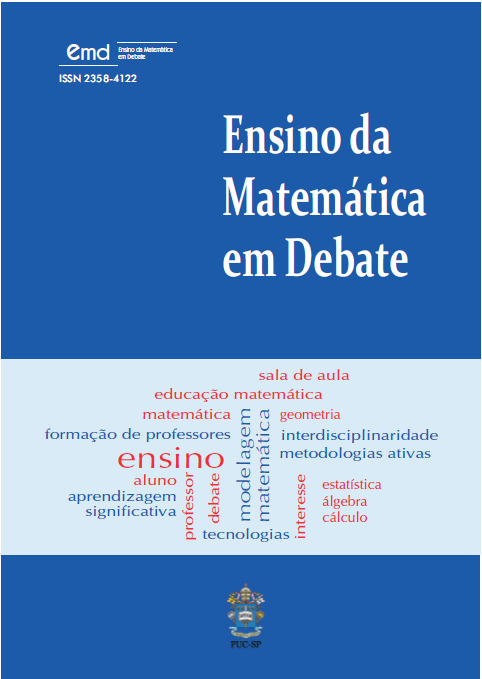Dynamic Folding and the Development of Geometric Thinking
Keywords:
Geometria Dinâmica, Dobraduras, Pensamento Geométrico, Argumentação em Geometria, Educação MatemáticaAbstract
This article presents research developed from the proposal for exploring dynamic folding that result in geometric figures, constructed in an environment of dynamic geometry and analyzes the development of geometric thinking and argumentation based on the exploration of this material. The investigation was conducted by an experiment, with students in the ninth grade of elementary school. Based on the elaborated dynamic activities, it was possible to develop essential aspects of geometric thinking, such as exploration, formulation and conjecture testing, as well as encouraging argumentation in the basic school. The material was developed in a digital book format at GeoGebrabook, and proposes the manipulation of dynamic geometric objects that simulate folds on sheets of paper, in which students were encouraged to explore and argue. We used the Van Hiele model of levels of understanding that sequentially describe characteristics of the geometric thinking process for the analysis of the experiment. The results show that, with the exploration of the virtual dynamic folds and the incentive to argumentation, it is possible to develop essential aspects of geometric thought and to recover the argumentation in the basic school.
References
BASSO, M. & NOTARE, M. Pensar com Tecnologias Digitais de Matemática Dinâmica. Revista Novas Tecnologias na Educação, v. 13, n. 2, 2015.
BOGDAN, R. & BIKLEN, S. Investigação qualitativa em educação: uma introdução à teoria e aos métodos. Portugal: Porto Editora, 1994.
CROWLEY, M. L. Aprendendo e Ensinando Geometria. O modelo Van Hiele de desenvolvimento do pensamento geométrico. São Paulo: Atual Editora LTDA, 1996, p. 1-20.
DE VILLIERS, M. The Role of Proof in Investigative, computer-based Geometry: Some personal reflections. Chapter in Schattschneider, D. & King, J. (1997). Geometry Turned On! Washington: MAA, p. 15-24, 1997.
GRAVINA, M. Os ambientes de geometria dinâmica e o pensamento hipotético-dedutivo (Tese de doutorado, curso de Pós-Graduação em informática na Educação, Universidade Federal do Rio Grande do Sul). UFRGS, Porto Alegre, 2001. Disponível em http://hdl.handle.net/10183/2545. Acesso em: 16/03/2019.
GRAVINA, M. & CONTIERO, L. Modelagem com o GeoGebra: uma possibilidade para a educação interdisciplinar? Revista Novas Tecnologias na Educação, v. 9, n. 1, 2011.
NASSER, L. A teoria de Van Hiele para o ensino de geometria. Anais do 1° Seminário internacional de educação matemática do Rio de Janeiro. Rio de Janeiro, p. 29-40, 1993.
NOTARE, M., BASSO, M. Tecnologia na Educação Matemática: Trilhando o caminho do fazer ao compreender. Revista Novas Tecnologias na Educação, Porto Alegre, v. 10, n. 3, 2012.
NOTARE, M., BASSO, M. Argumentação e Prova Matemática com Geometria Dinâmica. Revista Novas Tecnologias na Educação, v. 16, n. 1, 2018.
SANTOS-TRIGO, M., MORENO-ARMELLA, L. & CAMACHO-MACHÍN, M. Problem solving and the use of digital Technologies within the Mathematical Working space framework. ZDM Mathematics Education, 48, p. 827-842, 2016.
Downloads
Published
How to Cite
Issue
Section
License
Copyright (c) 2023 Ensino da Matemática em Debate

This work is licensed under a Creative Commons Attribution-NonCommercial 4.0 International License.

Este obra está licenciado com uma Licença Creative Commons Atribuição 4.0 Internacional.





